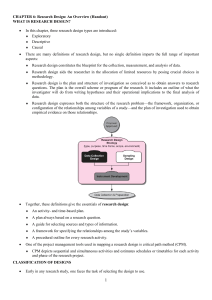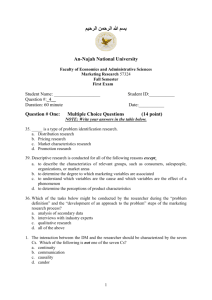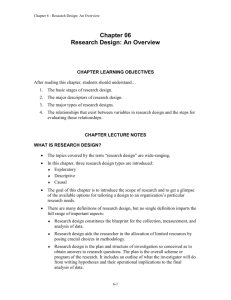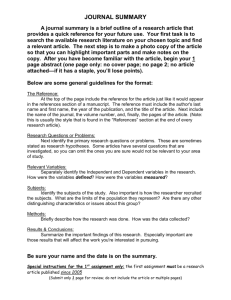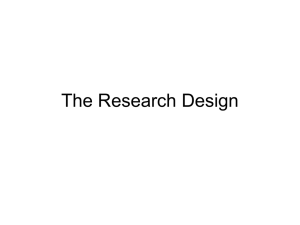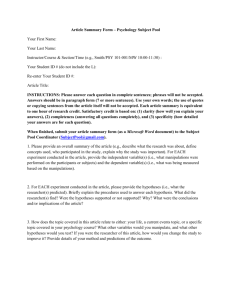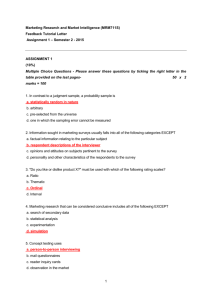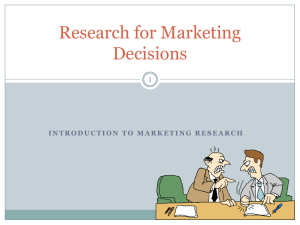CHAPTER 6: Research Design: An Overview (Handout) WHAT IS
advertisement
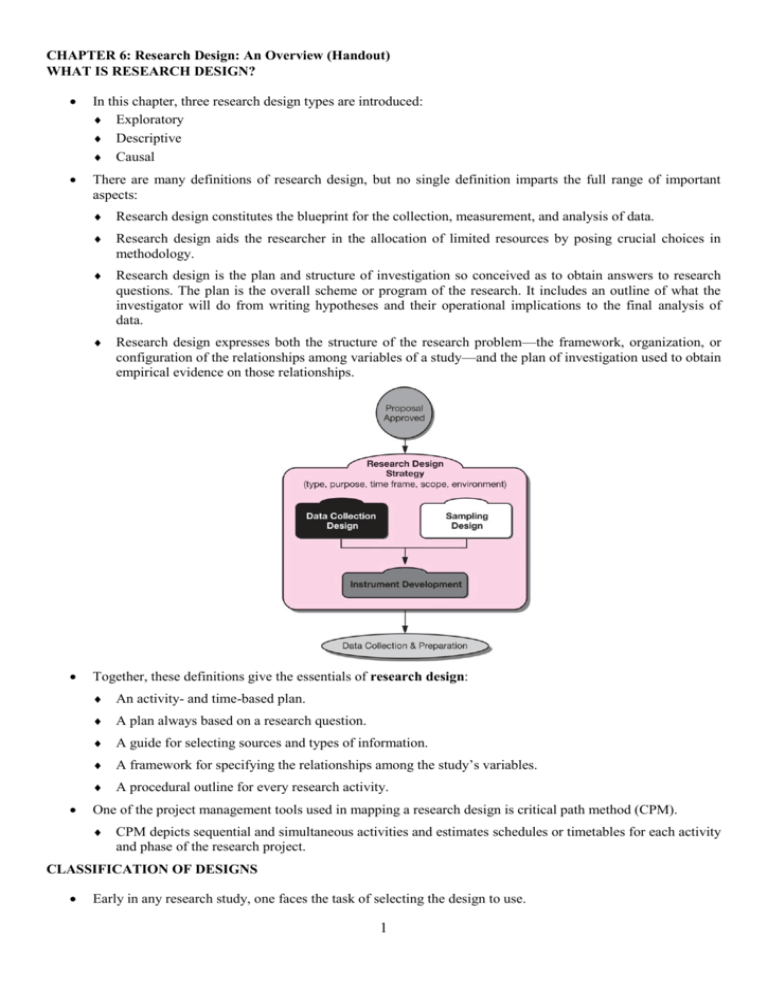
CHAPTER 6: Research Design: An Overview (Handout) WHAT IS RESEARCH DESIGN? In this chapter, three research design types are introduced: Exploratory Descriptive Causal There are many definitions of research design, but no single definition imparts the full range of important aspects: Research design constitutes the blueprint for the collection, measurement, and analysis of data. Research design aids the researcher in the allocation of limited resources by posing crucial choices in methodology. Research design is the plan and structure of investigation so conceived as to obtain answers to research questions. The plan is the overall scheme or program of the research. It includes an outline of what the investigator will do from writing hypotheses and their operational implications to the final analysis of data. Research design expresses both the structure of the research problem—the framework, organization, or configuration of the relationships among variables of a study—and the plan of investigation used to obtain empirical evidence on those relationships. Together, these definitions give the essentials of research design: An activity- and time-based plan. A plan always based on a research question. A guide for selecting sources and types of information. A framework for specifying the relationships among the study’s variables. A procedural outline for every research activity. One of the project management tools used in mapping a research design is critical path method (CPM). CPM depicts sequential and simultaneous activities and estimates schedules or timetables for each activity and phase of the research project. CLASSIFICATION OF DESIGNS Early in any research study, one faces the task of selecting the design to use. 1 Following are the eight different descriptors of research design. 1- Degree of Research Question Crystallization A study may be exploratory or formal. The distinctions between the two are the (a) degree of structure, and (b) the immediate objective of the study. Exploratory studies tend toward loose structures, with the objective of discovering future research tasks. – The immediate purpose is usually to develop hypotheses or questions for future research. The formal study begins where the exploration leaves off—with a hypothesis or research question. – It also involves precise procedures and data source specifications. – The goal of a formal design is to test the hypotheses or answer the research questions posed. 2- Method of Data Collection The method of data collection distinguishes between monitoring and communication processes. Monitoring includes studies in which the researcher inspects the activities of a subject or the nature of some material, without attempting to elicit responses from anyone. Examples of monitoring include: – Traffic counts at intersections – License plates recorded in a restaurant parking lot – A search of the library collection – The State Farm Dangerous Intersection Study In each case, the researcher notes and records the information available from observation. In a communication study, the researcher questions the subjects and collects their responses by personal or impersonal means. Collected data may result from: – – – Interview or telephone conversations. Self-administered or self-reported instruments through the mail, left in convenient locations, or transmitted electronically, or by other means. Instruments presented before and/or after a treatment or stimulus condition in an experiment. 3- Researcher Control of Variables In an experiment, the researcher attempts to control and/or manipulate the variables in the study. Experimental design is appropriate when one wishes to discover whether certain variables produce effects in other variables. Experimentation provides the most powerful support possible for a hypothesis of causation. With an ex post facto design, investigators have no control over the variables in the sense of being able to manipulate them. They can only report what has happened, or what is happening. Researchers using this design must not influence the variables; doing so introduces bias. The researcher is limited to holding factors constant by judicious selection of subjects, according to strict sampling procedures and by statistical manipulation of findings. 4- The Purpose of the Study The essential difference between reporting, descriptive, causal-explanatory and causal-predictive studies lies in their objectives. 2 A reporting study provides a summation of data, often recasting data to achieve a deeper understanding or to generate statistics for comparison. A descriptive study is concerned with finding out who, what, where, when, or how much. A causal-explanatory study is concerned with learning why. That is, how one variable produces changes in another variable. A causal-predictive study attempts to predict the effect on one variable by manipulating another variable while holding all other variables constant. 5- The Time Dimension Cross-sectional studies are carried out once, and represent a snapshot of one point in time. Longitudinal studies are repeated over an extended period. The advantage of a longitudinal study is that it can track changes over time. In longitudinal panel studies, researchers may study people over time. In marketing, panels are set up to report consumption data. These data provide information on relative market share, consumer response to new products, and new promotional methods. Some types of information cannot be collected a second time from the same person without the risk of bias. Some benefits of a longitudinal study can be revealed in a cross-sectional study by adroit questioning about past attitudes, history, and future expectations. 6- The Topical Scope Statistical studies are designed for breadth, rather than depth. They attempt to capture a population’s characteristics by making references from a sample’s characteristics. Generalizations about findings are based on the relativity of the sample and the validity of the design. Case studies place more emphasis on a full contextual analysis of fewer events or conditions, and their interrelations. The reliance on qualitative data makes support or rejection more difficult. An emphasis on detail provides valuable insight for problem solving, evaluation, and strategy. – This detail is secured from multiple sources of information. – It allows evidence to be verified and avoids missing data. Although they have a significant scientific role, case studies have been maligned as “scientifically worthless” because they do not meet the minimum requirements for comparison. – – Important scientific propositions have the form the universals, which can be falsified by a single counter-instance. A single, well-designed case study can provide a major challenge to a theory, and provide a source of new hypotheses and constructs simultaneously. 7- The Research Environment Designs differ as to whether they occur under actual environmental conditions (field conditions) or under staged/manipulated conditions (laboratory conditions). Simulations, which replicate the essence of a system or process, are increasingly used in research, especially in operations research. Conditions and relationships in actual situations are often represented in mathematical models. Role-playing and other behavioral activities may also be viewed as simulations. 3 8- Participants’ Perceptual Awareness Participant’s perceptual awareness refers to when people in a disguised study perceive that research is being conducted. Participant’s perceptual awareness may reduce the usefulness of a research design. Participants’ perceptual awareness influence the outcomes of the research. When participants believe that something out of the ordinary is happening, they may behave less naturally. There are three levels of perceptional awareness: a- Participants perceive no deviations from everyday routines (non-aware, unaffected). b- Participants perceive deviations, but as unrelated to the researcher (aware, consciously unaffected). c- Participants perceive deviations as researcher-induced (aware, consciously affected). I- EXPLORATORY STUDIES Exploration is particularly useful when researchers lack a clear idea of the problems they will meet during the study. Exploration allows researchers to: – Develop clearer concepts – Establish priorities – Develop operational definitions – Improve the final research design – Possibly save time and money If exploration reveals that a problem is not as important as first thought, more formal studies can be cancelled. Exploration serves other purposes as well: The area of investigation may be so new or vague that the researcher needs to do an exploration just to learn something about the dilemma. Important variables may not be known or well defined. A hypothesis for the research may be needed. The researcher may need to determine if it is feasible to do a formal study. Researchers and managers alike give exploration less attention than it deserves. There is often pressure for a quick answer. There may be a bias about qualitative research. Subjectiveness Non-representation Non-systematic design. Exploration can save time and money, so it should not be slighted. Qualitative Techniques Although both qualitative and quantitative techniques are applicable, exploration relies more heavily on qualitative techniques. There are multiple ways to investigate a management question, including: Individual depth interviews: usually conversational, rather than structured. Participant observation: perceive firsthand what participants experience Films, photographs, and videotape: to capture the life of the group under study. 4 Projective techniques and psychological testing: such as a Thematic Apperception Test, projective measures, games, or role-playing. Case studies: for an in-depth contextual analysis of a few events or conditions. Street ethnography: to discover how a cultural subgroups described and structures its world at street level. Elite or expert interviewing: for information from influential or well-informed people. Document analysis: to evaluate historical or contemporary confidential or public records, reports, government documents, and opinions. Proxemics and kinesics: to study the use of space and body-motion communication, respectively. When these approaches are combined, four exploratory techniques emerge: Secondary data analysis. Experience surveys. Focus groups. Tow-stage designs. Secondary Data Analysis The first step in an exploratory study is a search of the secondary literature. Studies made by others, for their own purposes, represent secondary data. It is inefficient to discover anew through the collection of primary data or original research what has already been done and reported. Start with an organization’s own archives. By reviewing prior studies, you can identify methodologies that proved successful and unsuccessful. Solutions that didn’t receive attention in the past may reveal subjects for further study. Avoid duplication in instances where prior data can help resolve the current dilemma. The second source of secondary data is published documents prepared by authors outside the sponsor organization. Data from secondary sources help us decide what needs to be done, and can be a rich source of hypotheses. In many cases, you can conduct a secondary search in libraries, or via your computer and an online service or an Internet gateway. If we confine an investigation to obvious subjects in bibliographic sources, some of the best information may be missed. We provide a detailed list of Business Reference Sources on the website. Experience Survey Published data are seldom more than a fraction of the existing knowledge in a field. A significant portion of what is known on a topic is proprietary to a given organization, and therefore unavailable to an outside researcher. Also, internal data archives are rarely well organized, making secondary sources difficult to locate. Thus, it is beneficial to seek information from persons experienced in the field of study, tapping into their memories and experiences. In an experience survey, we seek a person’s ideas about important issues or aspects of the subject and discover what is important across the subject’s range of knowledge. Avenues to explore: What is being done? 5 What has been tried in the past without success? With success? How have things changed? What are the change-producing elements of the situation? Who is involved in decisions and what role does each person play? What problem areas and barriers can be seen? What are the costs of the processes under study? Whom can we count on to assist and/or participate in the research? What are the priority areas? The product of such questioning may be: A new hypothesis The discarding of an old one Information about the practicality of doing the study Discovery of what facilities are available What factors need to be controlled, and how Who will cooperate in the study. Discovery is more easily carried out if we analyze cases that provide special insight. People who might provide insightful information include: Newcomers to the scene Marginal or peripheral individuals Individuals in transition Deviants and isolates “Pure” cases Those who fit well and those who do not Those who represent different positions in the system During the early phase of the MindWriter research study, Jason and Myra plan to interview: Managers of the service facility Managers of the call center Managers of the contract courier service Long-term employees of various departments Individuals associated with engineering and production Focus Groups Focus groups became widely used in the 1980s. A focus group is a group of people (typically 6 to 10), led by a trained moderator, who meet for 90 minutes to 2 hours. The facilitator or moderator uses group dynamics to focus or guide the group in an exchange of ideas, feelings, and experiences on a specific topic. One typical objective of a focus group might be a new product or product concept, a new employee motivation program, or improved production-line organization. The basic output of the session is a list of ideas and behavioral observations, with recommendations by the moderator, that are often used for later quantitative testing. 6 In another application, a large title insurance company ran focus groups with its branch office administrations to discover their preferences for distributing files on the company’s intranet. Two-Stage Design With a two-stage design approach, exploration becomes s separate first stage with limited objectives: Clearly define the research question Develop the research design Argument for a two-stage approach: we need to know more about the problem before resources are committed. This approach is particularly useful when the research budget in inflexible. A limited exploration for a specific, modest cost carries little risk for both the sponsor and the researcher. An exploratory study is finished when researchers have achieved the following: Major dimensions of the research task have been established. A set of subsidiary investigative questions that can guide a detailed research design have been defined. Several hypotheses about possible causes of a management dilemma have been developed. Certain hypotheses have been identified as being so remote that they can be safely ignored. A conclusion that additional research is not needed or is not feasible has been reached. II- DESCRIPTIVE STUDIES Formalized studies are typically structured with clearly states hypotheses or investigative questions. Research objectives: Descriptions of phenomena or characteristics associated with a subject population (the who, what, when, where, and how of a topic). Estimates of the proportions of a population that have these characteristics. Discover of associations among different variables (sometimes labeled a correlational study) A descriptive study may be simple or complex, and it may be done in many settings. The simplest study concerns a univariate question or hypothesis in which we ask about (or state something about) the size, form, distribution, or existence of a variable. In the account analysis at BankChoice, we might want to develop a profile of savers. Examples of other variables include: – Number of accounts opened in the last six months – Amount of account activity – Size of accounts – Number of accounts for minors Our task is to determine if the variables are interdependent or unrelated. If they are, we must determine the strength or magnitude of the relationship. Descriptive studies are often much more complex than the BankChoice example. III- CAUSAL STUDIES Statistically untrained undividual sometimes mistake correlation (the simultaneous occurance of two phenomena as causation. The essential element of causation is that A “produces” B or A “forces” B to occur. Empirically, we can never demonstrate an A-B causality with certainty. – Empirical conclusions are inferences (inductive conclusions). 7 – As such, they are based on what we observe and measure. – We cannot observe and measure all the processes that may account for the A-B relationship. In Chapter 3 we discussed the example of sales failing to increase following a promotion. Having ruled out other causes, we were left with the inference that was probably (but not certainly) the cause: a poorly executed promotion. Meeting the ideal standard of causation requires that one variable always causes another variable, and no other variable has the same causal effect. The method of agreement states that “When two or more cases of a given phenomenon have one and only one condition in common, then that condition may be regarded as the cause (or effect) of the phenomenon.” The method of agreement helps rule out some variables as irrelevant. A, B, D, and E are unlikely to be causes of Z. However, there is an implicit assumption that there are no variables to consider. – – – – No one can accept this supposition with certainty because the number of variables is infinite. In addition, while C may be the cause, it may instead function only in the presence of some other variable, which was not included. The negative canon of agreement states that where the absence of C is associated with the absence of Z, there is evidence of a causal relationship between C and Z. Together with the method of agreement, this forms the basis for the method of difference: “If there are two or more cases, and in one of them observation Z can be made, while in the other it cannot; and if variable C occurs when observation Z can be made, while in the other it cannot; and if variable C occurs when observation Z is made, and does not occur when observation Z is not made; then it can be asserted that there is a causal relationship between C and Z. No one can ever be certain that variable A causes variable B to occur, but one can gather evidence that increases the belief that A leads to B. We seek three types of evidence of causation: Covariation between A and B. – Do we find that A and B occur together in the way hypothesized? – When A does not occur, is there also an absence of B? – When there is more or less of A, does one also find more of less of B? Time order of events moving in the hypothesized direction. – Does A occur before B? No other possible causes of B. – No one can determine that C, D, and E do not covary with B in a way that suggests possible causal connections? In addition to the three conditions above, successful inference making from experimental designs must meet two additional requirements: Control: all factors, with the exception of the independent variable, must be held constant and not confound with another variable that is not part of the study. Random assignment: each person must have an equal chance for exposure to each level of the independent variable. If we consider the possible relationships that can occur between two variables, we can conclude that there are three possibilities: Symmetrical Reciprocal Asymmetrical A symmetrical relationship is one in which two variables fluctuate together, but we assume the changes in neither variable are due to changes in the other. 8 Symmetrical conditions are most often found when two variables are alternate indicators of another cause or independent variable. We might conclude that a correlation between low work attendance and active participation in a camping club is the result of (dependent on) another factor, such as a lifestyle preference. A reciprocal relationship exists when two variables mutually influence or reinforce each other. This could occur if reading an advertisement leads to the use of a product. The usage, in turn, sensitizes the person to notice and read more of the advertising for that product. Most research analysts look for asymmetrical relationships. With these, we postulate that changes in one independent variable (IV) are responsible for changes in a dependent variable (DV). The identification of the IV and DV is often obvious, but sometimes the choice is not clear. In these cases, dependence and independence should be evaluated on the basis of: – – The degree of which each variable may be altered. The time order between the variables. 9
